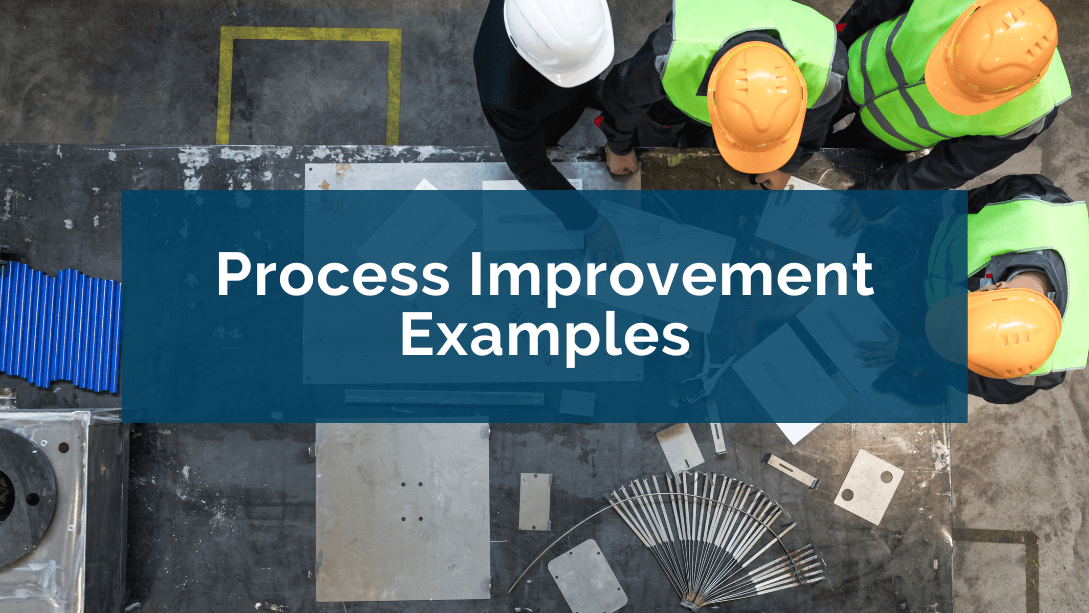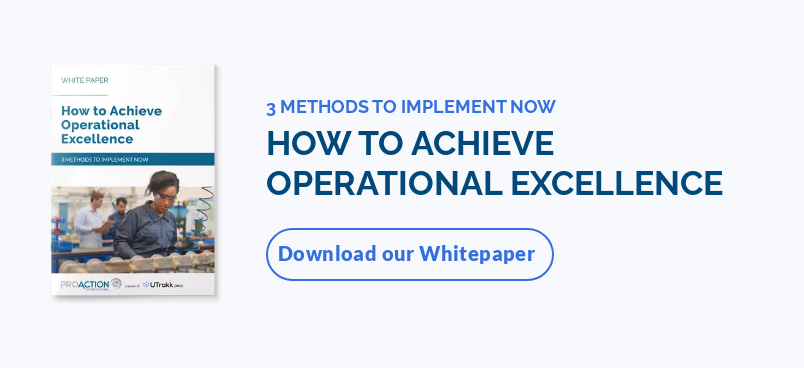What is process improvement and why is it important?
Process improvement means continually optimizing various aspects of production, from assembly lines and logistics to human resources management and quality control systems. These actions are an integral part of business processes, including all activities contributing to creating value for the company.
This structured approach aims to make each step smoother, more efficient, and aligned with the company's strategic objectives. For manufacturers, this means producing faster, at lower cost, while improving end-product quality to maximize customer satisfaction.
A company that pursues ongoing process improvement efforts doesn't just meet current needs; it anticipates future challenges, adapts to new market requirements, and can maintain its competitive edge.
To give you a clearer idea, here's an overview of the main benefits of process improvement:
- Cost reduction: Process optimization reduces waste, minimizes errors, and increases operational efficiency, resulting in significantly lower operating costs.
- Improved quality: Well-controlled processes minimize variations and defects, ensuring greater client satisfaction, and enhancing the company's reputation for high-quality products.
- Shorter lead times: By reducing cycle times and bottlenecks, streamlined processes enable faster production, faster deliveries, and lower work-in-process inventories.
- Greater flexibility: More flexible production adapts easily to customized orders and variations in demand, thanks to rapid transitions and agile operations management.
- Optimal use of resources: Improved processes maximize the efficiency of human and material resources, minimize waste, and boost productivity, while increasing employee engagement.
Process improvement methods to optimize manufacturing operations
|
Method |
Description |
How it works |
Impact on process improvement |
|
Lean |
Eliminate waste (unnecessary tasks, delays, excess inventory, etc.) to maximize added value. |
Continuous analysis of process steps to systematically identify and eliminate non-value-added elements. |
Cost reduction and improved process speed. |
|
Six Sigma |
Reduction of quality variations using rigorous statistical tools. |
DMAIC cycle (Define, Measure, Analyze, Improve, Control) to identify and correct inefficiencies. |
Improved product quality and increased customer satisfaction. |
|
Kaizen |
Continuous improvement method involving all employees. |
Regular meetings to propose ideas for improvement. Active participation from all levels of the company. |
Progressive and constant improvement of processes and increased employee commitment. |
|
Agile |
Adaptable, flexible method for rapid response to market changes. |
Works in iterative cycles (sprints) to test and adjust improvements. |
Adaptability to customer needs and improved collaboration between teams. |
|
Total Quality Management |
Quality improvement method involving all employees. |
Standardizing processes, training employees, and listening to customer needs. |
Reduced errors and improved entire process performance. |
|
PDCA (or Deming Wheel) |
Continuous improvement approach based on the following steps: Plan-Do-Check-Act. |
Each phase is repeated to ensure regular process improvement. |
Optimized performance, continuous adaptation, and better quality. |
9 examples of process improvements for your manufacturing facility

1. Improving workplace safety
Identifying potential hazards in the workplace and implementing preventive measures are essential to eliminating or at least minimizing risk. This helps reduce accidents, protect employees, and create a safer working environment.
Example: A chemical plant introduced weekly safety training and regular equipment inspections, significantly reducing accidents.
2. Eliminating waste
All activities that do not directly contribute to the value of the final product are identified and eliminated. These may include overproduction, unnecessary delays, unnecessary movement of employees or raw materials, and excessive inventories.
Example: A furniture manufacturing plant redesigned its workspace to reduce employee travel, thereby reducing production time and optimizing the use of materials.
3. Process automation
Computer systems and machines carry out repetitive, manual tasks that previously required human operators' time. This minimizes human error, increases the speed of execution, and frees up employees to concentrate on higher-value-added activities.
Example: An electronic components factory has automated production data entry, freeing operators to focus on more technical activities, such as equipment maintenance.
4. Reduced waiting times
The organization of tasks and resources is optimized to ensure that each production stage starts without delay. This avoids idle periods between stages and maintains a continuous workflow.
Example: An automotive production plant has synchronized the delivery of parts with the stages of the assembly line, thus reducing the waiting time between each phase and improving the fluidity of the process.
5. Reducing production costs
Reducing costs is crucial to efficiently use resources such as raw materials, energy, and working time. It cuts expenditures while preserving product quality. Cost reductions also involve identifying waste, negotiating better contracts with suppliers, and optimizing processes for maximum efficiency.
Example: A textile factory renegotiated its supply contracts with suppliers and rationalized the use of raw materials, thereby cutting costs and increasing profitability while maintaining a high level of quality.
6. Reduced production defects
Product quality is improved by identifying the sources of problems and eliminating them at the root. The result is fewer manufacturing defects, lower error correction costs, and greater client satisfaction, as customers receive reliable products that meet their expectations.
Example: In a glass production plant, applying the Six Sigma method has reduced the number of air bubbles in finished products, thereby increasing the quality of the glass produced.
7. Optimizing the use of resources
Optimizing resources means using equipment, workers, and raw materials to reduce waste and maximize productivity. This means effectively planning the use of machinery, allocating each activity wisely among employees, and carefully managing raw materials to avoid unnecessary waste.
Example: An agricultural machinery manufacturing plant has implemented a resource management system, which has enabled better coordination of equipment use and reduced downtime, thus increasing overall productivity.
8. Improve process visibility and transparency
Improving visibility means ensuring that all stakeholders can easily access important information on the status of ongoing processes. Making this data transparent and accessible enables everyone to track progress, detect problems early, and make fact-based decisions, thus improving the company's overall responsiveness.
Example: In a food processing plant, manufacturing dashboards have enabled production managers to monitor the various production lines' status more effectively. This transparency has facilitated the detection of bottlenecks and improved decision-making, optimizing overall performance.
9. Improved communication and collaboration
Good communication breaks down organizational silos and strengthens collaboration between different teams. This facilitates information sharing, which is essential for resolving problems and improving overall efficiency, in addition to building a company culture based on collaboration.
Example: Daily meetings were set up between the production and logistics teams in an appliance assembly plant. This allowed production problems to be resolved quickly, reduced downtime, and increased productivity.
How digital tools continuously improve business processes
Technology is a powerful leverage for ongoing process improvement. If you're wondering how the UTrakk daily management platform support such initiative, here are some of its key features:
Gemba Walks
UTrakk simplifies the planning and execution of daily Gemba Walks, through which managers walk the production floor to ensure that business processes are working properly and meeting operational goals, and identify any problems that may arise. Corrective actions can be created on the spot and monitored effectively during the next floor tours.
Digitalized floor tours in the solution include:
- Customized digital checklists to monitor and control checkpoints that are relevant to your SQCDP performance areas.
- A view of qualitative and quantitative floor data to assess work progress.
- Creation of corrective actions as soon as a variance or problem is identified.
Dashboards
UTrakk dashboards make it easy to visualize process improvement indicators and variances. This helps make decisions based on concrete data and implement improvement actions that will have an impact on operational performance. The dashboards will then enable you to track data and compare results from before and after the implementation of these corrective actions.
The solution's dashboards include:
- Manual KPI input and/or automated data integration from third-party software for a complete view of operational performance.
- Real-time visualization of critical operational data, enabling quick and appropriate actions to correct any variances.
- User-friendly options for creating customized dashboards to track data that is relevant to your performance areas.
Project tracking
UTrakk's project tracking tools enable you to design continuous improvement plans and ensure that each step is completed on time, with the right resources.
The solution's Projects module includes:
- Simplified action planning and assignment of owners and deadlines to ensure timely execution of improvement plans.
- Gantt charts providing a clear view of the progress of improvement projects and related tasks.
- Ability to link business process improvement projects to recurring meetings, enabling rigorous and regular follow-up.
Collaboration and rituals
Setting up regular collaboration rituals – production meetings, continuous improvement committees, etc. – with the UTrakk digital platform enables teams to ensure rigorous follow-up of improvement initiatives. These rituals are ideal touchpoints for assessing progress, adjusting strategies, and fostering employee engagement.
Features included in the platform's Rituals module are:
- Scheduling of meetings and communication rituals and synchronization with calendars from other applications, for greater organization and efficiency.
- Integration of essential information and tools in each management touchpoint, including agendas, documents, dashboards, discussion threads, and more.
- Creation of execution workflows to track process improvement projects during meetings.
Unlocking operational excellence through continuous process improvement
Process improvement is the cornerstone of operational excellence. By relying on tools like UTrakk to guide and structure these initiatives, organizations can turn challenges into opportunities, reduce defects, eliminate waste, and strengthen team collaboration. When carried out with determination, these actions lead to maximum efficiency, enhanced customer satisfaction, and a sustainable competitive advantage.
Of course, we're talking about efficiency gains, but that's not all. Process improvement advocates continuous evolution and pushes the organization that embraces it to strive for excellence, one step at a time. Whether you start by eliminating a particular waste, improving safety, or automating a repetitive task, for example, know that every action counts. These first steps build a solid foundation for the future, paving the way for a broader transformation of your manufacturing operation.









